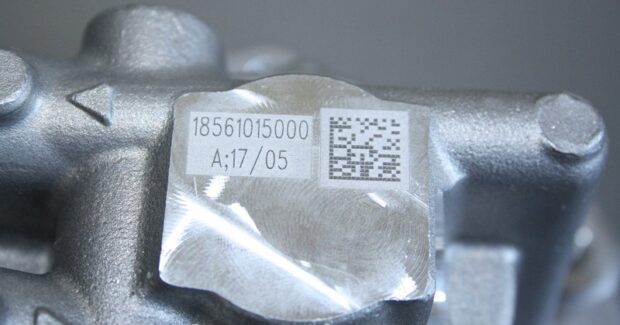The Growing Importance of Direct Part Marking
Traditionally used for fast, error-free traceability of parts in aerospace, medical, automotive and electronics applications, imprinting information directly on parts is ideal for service or recall and assistance in liability and warranty resolution – and it will be needed everywhere as automation and robotics sweep across shop floor operations in Industry 4.0.
Posted: October 11, 2019
As automation and robotics sweep across shop floor operations, more manufacturers are recognizing ways to get bigger boosts in productivity, quality assurance and inventory management from the use of digital information, such as directly marking parts with serial numbers, part numbers, date codes, and machine-readable information that allow for efficient and economic tracking of those parts throughout the manufacturing process and supply chain. Traditionally used for fast, error-free traceability of parts by suppliers to the aerospace, medical, automotive and electronics industries, direct part marking is ideal for locating parts for service or recall and can be used to assist in liability and warranty resolution – and it will only grow in importance as metalworking competition in Industry 4.0 expands.
Information can be imprinted directly on parts made from a wide variety of materials, but the appropriate technology must be selected to match the unique aspects of the part’s base material, including its roughness, ability to withstand thermal stress, and its fragility.1 There are many different ways to directly mark a part, with each marking method having its own strengths and applications. Here are some of the latest direct part marking systems:
Fiber Laser Marking for High Volume Production
The versatile, easy-to-operate XL-Box from SIC Marking USA uses a high powered, pulsed-wave ytterbium-doped fiber laser for shallow or deep markings of alphanumeric codes, barcodes and 2D Data Matric codes on all metals and some plastics.
How to Make Permanent Part Marking Easy
For directly marking small parts up to full sheets, X Series, Tag Master 3 and KM-1207 benchtop dot peen marker systems from Kwik Mark can process flat, curved and irregular surfaces on materials ranging from hardened tool steels to delicate plastics.
High Speed Metal or Plastic Marking with Superior Edge Quality
For high quality customized marking or engraving, the TruMark 5020 fiber laser marker from TRUMPF converts high pulse frequencies up to 1 MHz into high speeds for short marking processes.
Silence Is Golden: Versatile Deep Part Marking of Hard Materials
The C-Series Silent Scribe marking system and Sound Abatement System from Columbia Marking Tools quietly marks new types of alloys, steels, high-strength low-alloy steel (HSLA) and different formulations of casting materials that require versatile marking pressure capabilities.
Mounted CO2 Laser Lenses Field Replacements for Marking Systems
Drop-in field replacement CO2 laser lenses from Laser Research Optics can reduce downtime, provide < 0.2 percent total absorption values and are coated to match specific phase and polarization requirements.
References
1. “Technical Guide: Methods for Direct Part Marking,” Videojet Technologies, Inc., 2014, tg-methods-for-direct-part-marking-us.pdf, www.videojet.com.















